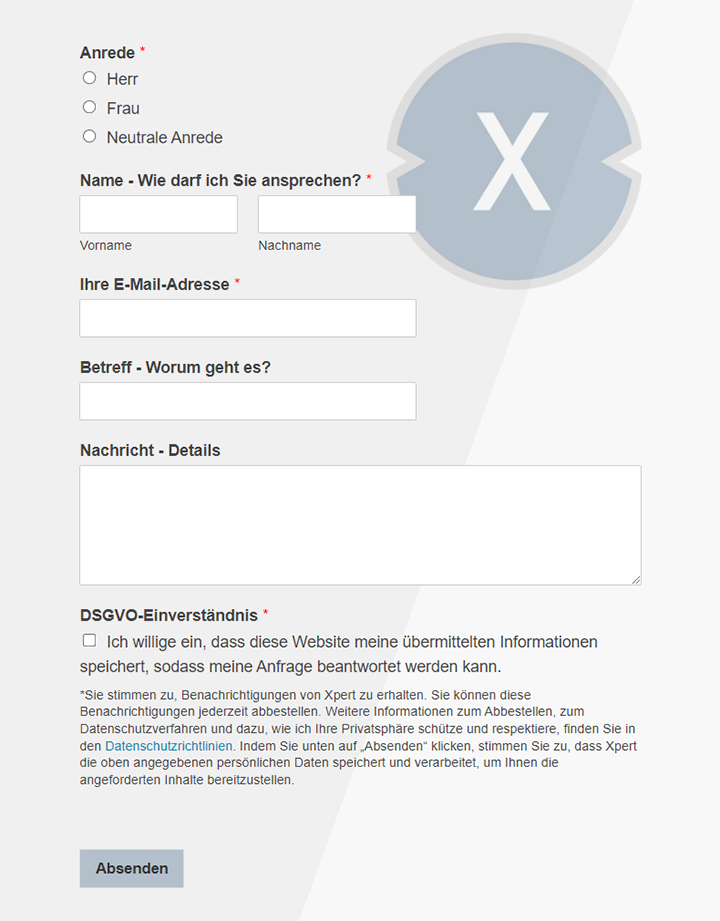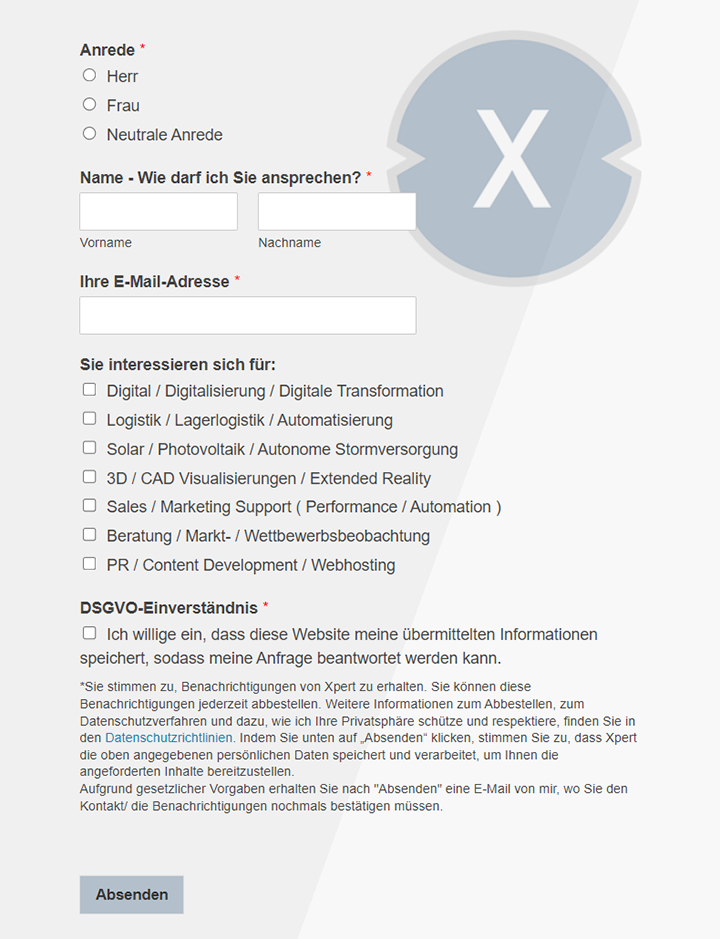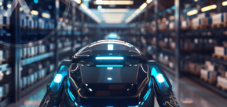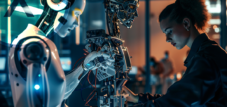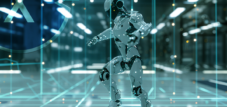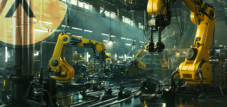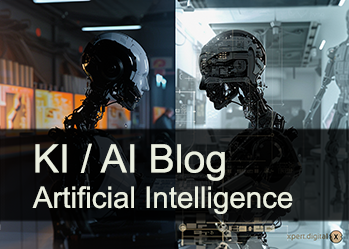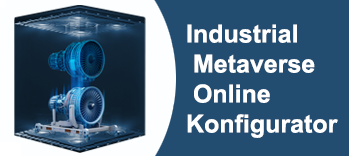Advances in Robotics Technology: A Comprehensive Overview
Xpert pre-release
Language selection 📢
Published on: August 17, 2025 / Updated on: August 17, 2025 – Author: Konrad Wolfenstein
Modular heavy-duty systems: Scalable solutions for automotive and steel
What are the latest developments in high-performance heavy-duty robots?
The robotics industry is currently experiencing a remarkable upswing in the development of heavy-duty robots capable of moving impressive loads. A prime example of this development is Estun's new ER1000-3300 heavy-duty robot, which celebrated its world premiere at Automatica 2025. This innovative robot can handle payloads of up to 1,000 kilograms and achieves a reach of 3,300 millimeters. What's particularly impressive is its repeatability of ±0.1 millimeters despite the enormous payload.
The technical specifications of this robot illustrate the advances in robotics technology: With a deadweight of 4,850 kilograms, the ER1000-3300 achieves a deadweight-to-payload ratio of less than 5, enabling comparatively "tight speeds" of 68°/s in axis 1 to 101°/s in axis 6. The rigid design allows for wrist torques of 9,000 Nm in axis J5 and 6,000 Nm in axis J6, with a permissible load moment of inertia of 1,800 kg/m² and 850 kg/m², respectively.
But Estun isn't the only manufacturer innovating in this segment. Kuka presented the "KR Titan ultra," an even more powerful robot capable of moving payloads of up to 1,500 kilograms while weighing just 4.5 tons. This robot boasts a reach of up to 4,200 millimeters and a high payload, and is highly market-oriented and tailored to the needs of automotive and Tier 1 customers.
The application areas for these heavy-duty robots are diverse and strategically important. They are particularly suitable for heavy-duty applications in the steel and automotive industries, as well as in construction machinery. A particularly important target market is battery assembly lines in the automotive industry, a market in which Estun already holds a market-leading position in China. The modular design ensures compatibility and scalability between the various robot series, which is beneficial for both manufacturers and users.
Estun already has an impressive track record in developing heavy-duty robots. The company previously launched a 700-kilogram payload robot using proprietary dynamic algorithms and lightweight structural designs. These innovations have led to Estun's heavy-duty robots being included in the Ministry of Industry and Information Technology's funding catalog for the application of first-in-class key technologies.
How are humanoid robots revolutionizing the music world and other areas?
The development of humanoid robots has made remarkable progress in recent years, particularly in the area of creative applications. One fascinating example is the "Robot Drummer," a project by researchers from the University of Applied Sciences and Arts of Italian Switzerland, the Dalle Molle Research Institute for Artificial Intelligence, and the Politecnico di Milano. This humanoid robot can play complex pieces of music, from jazz to metal, with a rhythmic accuracy of over 90 percent.
What's special about this project is the innovative training method called "Rhythmic Contact Chain," in which music is represented as a precisely timed sequence of drum contacts. The researchers extract the percussion channels from MIDI files and convert them into precise beat timings for the robot. Through reinforcement learning in a simulation environment, the robot independently developed human-like techniques such as crossing its arms, dynamically switching drumsticks, and optimizing its movements across the entire drum set.
The Unitree G1, a 1.2-meter-tall, approximately 35-kilogram humanoid robot priced at $16,000, was used for the tests. The G1 has 23 degrees of freedom, and extended versions can achieve up to 43 degrees of freedom, giving it the flexibility to perform complex motion sequences. The robot drummer's repertoire encompasses a wide variety of musical genres – from Dave Brubeck's jazz classic "Take Five" to Bon Jovi's "Living on a Prayer" to Linkin Park's "In the End."
Another interesting example is ZRob, a drum robot from the University of Oslo, which has a flexible "wrist" that allows it to loosen the grip on the drumsticks, similar to a human wrist. This robot can listen to itself playing the drums and uses reinforcement learning to improve its playing. The researchers argue that people often use their own bodies through movement to add expression to the playing of an instrument.
But other manufacturers have also tried their hand at making musical robots. Xiaomi's CyberOne can also play the drums and, according to the manufacturer, automatically converts a MIDI track into drum beats. The robot has 13 joints, and its whole-body movements are synchronized with the music.
But humanoid robots aren't limited to musical applications. The vision for humanoid robots goes far beyond that: They are intended to become all-purpose tools that can independently load a dishwasher and work equally well elsewhere on an assembly line. Industrial manufacturers are focusing on humanoids specifically developed for industrial tasks.
The next step in development is transferring the learned skills from the simulation to real hardware. The researchers are also working on teaching the robot improvisation skills so it can respond to musical cues in real time. This would enable Robot Drummer to "feel" and respond to music like a human drummer.
Which specialized robots are revolutionizing agriculture?
An outstanding example of specialized robots in agriculture is SHIVAA, a robot developed by the German Research Center for Artificial Intelligence for the fully autonomous harvesting of strawberries in open-field crops. This innovative robot impressively demonstrates how artificial intelligence and robotics can work together to revolutionize agricultural processes.
SHIVAA was deliberately developed for use in open fields, where the natural cultivation of strawberries results in an ecologically sound end product. Positioned at the edge of the field, the robot uses a 3D camera to independently detect the field structure and approach the first row of plants. Once there, additional cameras, which also process invisible light, identify the position and ripeness of the strawberries.
The harvesting process itself is remarkably precise: Using two grippers, the ripe fruits are picked from the plants beneath the robot. Like a human, the gripper's fingers grasp the strawberry and separate it from the plant with a twisting motion. The robot arm, complete with gripper, swiftly moves to the crate above and places the strawberry.
SHIVAA's performance data is quite impressive: The robot can harvest approximately 15 kilograms of fruit per hour and is capable of operating for at least eight hours at a time. This capacity makes it a valuable support for farms struggling with rising labor costs and labor shortages.
A particular advantage of SHIVAA is its ability to operate at night. Constant artificial lighting creates even more favorable conditions for the robot's image processing algorithms. Furthermore, the robot can pick alongside humans, allowing it to be seamlessly integrated into a farm.
The system is being developed in collaboration with, among others, the Hamburg University of Applied Sciences and is currently being tested at the Glantz strawberry farm in Hohen Wieschendorf, Mecklenburg-Western Pomerania. The manager of the Glantz strawberry farm, Jan van Leeuwen, is pleased to be involved in the project in light of growing economic pressure, as a good 60 percent of production costs are labor costs.
According to project manager Heiner Peters, several more years of development are needed before the robot can be mass-produced. It could take up to seven years before the product can be deployed in larger quantities in fields. However, SHIVAA is not the first fully autonomous robot developed to assist with strawberry harvesting. What sets it apart from comparable systems, which primarily operate in greenhouses, is its specific development for open-field cultivation.
In the future, the technology could also be applied to harvesting other types of fruit. Peters hopes that the robots will reduce production costs to such an extent that strawberries will once again be offered more cheaply in supermarkets, and that farms in this country can compete with imports from abroad through more efficient production.
According to the developers, the technology is not intended to replace human workers, but rather to support and relieve them. Farms could use the robots to avoid crop losses and maintain fruit quality.
How does collaborative robotics change the way humans and machines work together?
Collaborative robotics, also known as cobots, represents a paradigmatic shift in the way humans and robots work together. Unlike traditional industrial robots, which must operate behind protective fences, collaborative robots are specifically designed to interact safely and effectively with humans in a shared work environment.
There are different levels of human-robot interaction, ranging from full automation to true collaboration. With full automation, humans and robots work in their own workspaces, spatially separated by a protective fence. With coexistence, this protective fence is removed, but humans and robots continue to work separately in their respective workspaces.
In collaboration, humans and robots share a shared workspace and work sequentially, but generally do not touch each other. The highest level is human-robot collaboration, where contact between humans and robots is possible and sometimes explicitly necessary, as both usually work together simultaneously.
Cobots use sensors, cameras, and artificial intelligence to control their movements and ensure they don't harm humans. They can help perform repetitive, tiring, and precise tasks, allowing human workers to focus on more complex and creative activities. Cobots can perform a wide variety of tasks, such as grasping, lifting, and placing parts, assembling, as well as welding, gluing, drilling, milling, grinding, and polishing.
A particularly interesting example of practical application can be found at the LAT Group, a company that operates in everything from safety technology to traction power, covering everything from track to public transport. The company employs a sensor-equipped robot dog named Spot, which autonomously identifies damaged cables in subway tunnels, for example. If deployed across the board, this could ideally save more than 500 million euros per year.
The areas of application for collaborative robotics will expand significantly in the coming years. Felix Strohmeier, who heads the "Internet of Things" research group at Salzburg Research, is convinced that collaborative robots will also be used outside of factories in the next ten years: "You will find them on construction sites and in other areas. In road maintenance and agriculture, products already exist that work collaboratively or at least operate autonomously."
The CONCERT project is developing a novel type of collaborative robot that will be able to work safely with workers. These robots will be more robust than humans, possess autonomous capabilities, and exhibit collaborative intelligence. Collaboration between robot and user will take place via modern interfaces and interactive tools.
The CONCERT robots will be able to gather information from their environment and execute higher-level instructions, for example, for remote-controlled tasks where they adapt autonomously to the environment. Teleoperation will play a particularly important role when performing high-risk construction tasks, such as applying chemicals, while protecting the operator.
Traditionally, robots have been viewed as replacements for human workers. However, cobots take a different approach and focus on collaboration. These robots are designed to work alongside humans, assisting them in tasks and processes where human skills are irreplaceable.
The integration of robots is significantly changing workplace dynamics. Instead of replacing human workers, cobots are taking over repetitive and dangerous tasks, allowing workers to focus on more complex tasks that require creativity, empathy, and decision-making. This opens the door to a redefinition of job functions and a shift toward more value-driven work.
One of the most important benefits of human-robot collaboration is improved overall efficiency. Cobots are programmed to perform tasks with precision and speed, accelerating production processes. Humans can focus on tasks that require creativity and human intelligence, increasing the team's overall productivity.
The goal of human-robot collaboration is to combine the strengths of humans – dexterity, flexibility, and adaptability – with the strengths of robots – strength and endurance – to create processes that are both flexible and productive. To ensure safe work, collaborative robots have internal sensors that detect collisions, stop the robot, and thus eliminate any danger to humans.
Although automation and artificial intelligence continue to advance, the human touch remains a valuable asset. Cobots can't match the empathy, emotional intelligence, and human intuition that are crucial in certain professions. The interplay between human qualities and robotic capabilities creates a synergistic work environment that combines the best of both worlds.
🎯🎯🎯 Benefit from Xpert.Digital's extensive, fivefold expertise in a comprehensive service package | R&D, XR, PR & SEM

AI & XR-3D-Rendering Machine: five times expertise from Xpert.digital in a comprehensive service package, R&D XR, Pr & SEM – Image: Xpert.digital
Xpert.Digital has in-depth knowledge of various industries. This allows us to develop tailor-made strategies that are tailored precisely to the requirements and challenges of your specific market segment. By continually analyzing market trends and following industry developments, we can act with foresight and offer innovative solutions. Through the combination of experience and knowledge, we generate added value and give our customers a decisive competitive advantage.
More about it here:
Mobile Cobots and Fleet Management: The Next Wave of Automation
What role does artificial intelligence play in modern robotic systems?
Artificial intelligence has become an indispensable component of modern robotic systems, revolutionizing the way robots learn, decide, and interact with their environment. The use of AI technologies in robotics is continuously increasing, opening up entirely new possibilities for autonomous and intelligent machines.
Machine learning is one of the most important AI technologies in robotics. It allows a robot to learn to recognize patterns and make predictions based on data and experience. Algorithms such as supervised learning, unsupervised learning, or reinforcement learning enable robots to recognize objects, understand language, or imitate human movements.
Particularly impressive is the development of generative AI, which enables robots to learn from training and create something new. Robot manufacturers are developing generative AI-driven interfaces to program robots more intuitively: Users program using natural language instead of code. Workers no longer need specialized programming knowledge to select and customize the desired robot actions.
Another example is forward-looking AI, which analyzes robot performance data to determine the future condition of equipment. forward-looking maintenance can help manufacturers save on machine downtime costs. In the automotive supply industry, each hour of unplanned downtime costs an estimated $1.3 million.
Neural networks are AI models based on the structure and function of the human brain. They consist of interconnected artificial neurons and can solve complex pattern recognition tasks. Neural networks are used in robots to improve visual perception, language processing, and decision-making.
Computer vision is another critical AI technology that gives robots the ability to interpret and understand visual information from images or videos. Using AI algorithms, robots can detect, track, and interpret objects, faces, gestures, and other visual features. This enables them to navigate their environment, perform tasks, and interact with objects and people.
The Karlsruhe Institute of Technology, together with partners, has developed innovative collaborative learning methods that allow robots from different companies at different locations to learn from each other. Federated learning allows training data from multiple stations, multiple plants, or even multiple companies to be used without requiring participants to disclose sensitive company data.
For training in the FLAIROP project, there was no exchange of data such as images or grasp points. Instead, only the local parameters of the neural networks, i.e., highly abstracted knowledge, were transferred to a central server. There, the weights from all stations were collected and combined using various algorithms. The improved version was then played back to the stations on site and further trained on the local data.
The development of physical AI marks another important milestone. Robot and chip manufacturers like Nvidia are currently investing in the development of specialized hardware and software that simulate real-world environments so that robots can train themselves in such virtual environments. Experience replaces traditional programming.
Analytical AI allows large amounts of data captured by robot sensors to be processed and analyzed. This helps respond to unpredictable situations or changing conditions in public spaces or during production. Robots equipped with image processing systems analyze their work steps to recognize patterns and optimize workflows.
Natural Language Processing enables robots to understand, interpret, and respond to natural language. AI models are used to analyze user input, answer questions, conduct dialogues, and generate text. NLP enables interaction with robots through spoken or written language.
Reinforcement learning is a form of machine learning in which a robot is rewarded with positive reinforcement when it performs a specific action and punished with negative reinforcement when it performs an unfavorable action. The robot learns through trial and error to choose optimal actions in specific situations, training complex movements or navigation in dynamic environments.
Machine learning algorithms can also be used to analyze data from multiple robots operating simultaneously and optimize processes based on this information. In general, the more data a machine learning algorithm receives, the better its performance.
How is the market for autonomous mobile robots developing?
The market for autonomous mobile robots is currently experiencing exceptional growth and is considered one of the most dynamic segments of the robotics industry. The global AMR market size was valued at $2.8 billion in 2024 and is expected to grow at a CAGR of 17.6 percent from 2025 to 2034.
The robust growth of e-commerce and omnichannel commerce has significantly boosted the use of AMRs for sorting, transportation, assembly, and inventory management. According to the International Trade Administration, the global B2C e-commerce market is expected to reach $5.5 trillion by 2027, growing at a compound annual growth rate of 14.4 percent. This increase directly increases the demand for AMRs in warehousing and logistics.
Autonomous navigation enables maximum flexibility in route planning and mapping in mobile robotics. With the help of the fleet manager, companies can monitor their autonomous material transport and analyze the recorded production data. AMR systems are available in a wide variety of designs, including cart transporters, cleanroom versions, ESD models, and with customized superstructures and complementary systems.
It is used in electronics manufacturing, manufacturing plants, logistics centers, the automotive industry, the pharmaceutical industry, and medical technology. At Automatica 2025, Omron presented the new "OL-450S" mobile robot, an autonomous mobile robot specifically designed for transporting trolleys and racks. With its integrated lifting function, it enables flexible material flow without interfering with existing infrastructure.
Node Robotics presents Node.OS, an intelligent software platform that enables autonomous mobile robots and driverless transport systems to work together efficiently and collaboratively. The platform offers precise localization and navigation, intelligent route planning, and scalable fleet management, and can be seamlessly integrated into existing automation systems.
Thanks to its hardware-independent architecture, the software enables the flexible integration of different robot models and sensor systems. The new Traffic Manager optimizes the efficiency, coordination, and utilization of robot fleets and ensures smoother material flow in complex industrial environments.
DS Automotion presents Amy, a compact and cost-effective autonomous mobile robot suitable for small load transport up to 25 kilograms. It impresses with its ease of use and high flexibility. A transfer concept with an active lifting table allows sources and sinks to be designed as passive stations, making cost-effective implementation and scaling very easy, even in existing systems.
The future of AMR technology will be significantly shaped by continued advances in artificial intelligence for improved navigation, object recognition, and decision-making. Improved sensor technologies, including more sophisticated LiDAR systems and 3D cameras, will enable AMRs to gain a more comprehensive and accurate understanding of their environment.
Ongoing improvements in battery technology will lead to longer operating times and faster charging capabilities, thus improving the practicality and efficiency of AMR operations. The increasing adoption of fleet management software and cloud-based platforms will enable better coordination, monitoring, and optimization of large AMR operations.
The emergence of mobile cobots, which combine the mobility of AMRs with the collaborative capabilities of cobots, is expected to open up new applications in fields such as electronics and battery production. DS Automotion's Amy can operate fully autonomously or follow a virtual lane, even avoiding unexpected obstacles if desired.
The global AMR market is experiencing rapid growth. Current estimates indicate that the market will have already reached considerable dimensions by 2024 and will grow exponentially in the coming years. Autonomous mobile robot manufacturers must develop sophisticated AMRs designed for e-commerce warehousing, specifically for sorting, transportation, and inventory management.
What impact does robotics have on the labor market?
The impact of robotics on the labor market is more complex than originally assumed and differs significantly from the gloomy forecasts that prevailed a few years ago. A comprehensive study by researchers from the Institute for Employment Research (IAB), the University of Mannheim, and the University of Düsseldorf shows that, although 275,000 jobs were lost in German industry between 1994 and 2014 due to the use of robots, this was not due to layoffs, but rather because fewer young people were hired.
At the same time, the same number of new jobs were created in the service sector, meaning that the number of jobs barely changed overall. This stands in stark contrast to the US, where industrial workers have lost their jobs in droves due to automation, even though the German economy uses significantly more robots than the US industry, relative to the number of employees.
The trade unions in Germany play an important role in this. They have succeeded in preserving jobs in industry, but at the same time, they have had little scope to enforce higher wages for less qualified workers. A large proportion of workers are earning less due to automation. This particularly affects medium-skilled workers, such as skilled workers, whose jobs involve many robots.
The primary beneficiaries are those with higher qualifications and those companies that have been able to convert rising productivity into higher profits. This finding is confirmed by a study by the Center for European Economic Research in Mannheim, which found that the use of automation technologies generally leads to job cuts, but at the same time, new jobs are created that compensate for the lost positions.
ZEW researchers conclude that automation will be responsible for 560,000 new jobs between 2016 and 2021. The energy and water supply sectors will benefit most, with job growth of 3.3 percent. A positive trend is also evident in the electronics and automotive sectors, with job growth of 3.2 percent. In other manufacturing sectors, the calculated job increase is even 4 percent.
The development is critical, however, in the construction industry, where approximately 4.9 percent of jobs are expected to be lost. The education, healthcare, and social services sectors may also lose workers due to automation. Nevertheless, the overall balance is positive, as more new jobs are being created than lost.
A key driver for automation is the shortage of skilled workers. Seventy-five percent of respondents in a survey conducted by the Automatica Trend Index expect robotics to offer a solution. The vast majority of employees in Germany believe that robots in factories ensure the country's competitiveness. Around three-quarters of respondents expect robots to help strengthen competitiveness and keep industrial production in their own country.
The trend index records particularly high approval ratings for the question of whether robotics and automation will improve the future of work: The vast majority want robots to take over dirty, boring, and dangerous tasks in the factory. 85 percent believe that robots reduce the risk of injury in hazardous activities, and 84 percent see robots as an important solution for handling critical materials.
In the manufacturing industry, numerous jobs have already been replaced by robots, but this is also leading to the creation of new jobs in areas such as robot programming and maintenance. Robots and artificial intelligence are also increasingly being used in other sectors, such as retail and healthcare.
In the future, collaboration between humans and machines will become increasingly important. While certain tasks will be taken over by machines, others will still need to be performed by humans. Instead of replacing human workers, robots will take over repetitive and dangerous tasks, allowing workers to focus on more complex tasks that require creativity, empathy, and decision-making.
Terry Gregory of the IZA Institute of Labor Economics doesn't believe that robots will completely replace humans in many jobs. He believes that computers create more jobs than they destroy. But everyone agrees on one thing: work will change. Some jobs will no longer exist, robots will become colleagues, and we can forget about sitting at the same desk for 40 years.
The Institute for Employment Research (IAB) predicts that as many new jobs will be created as will be lost. Experts at the Cologne Institute for Economic Research predict: We don't have to fear robots. They won't take all of our jobs.
Our recommendation: 🌍 Limitless reach 🔗 Networked 🌐 Multilingual 💪 Strong sales: 💡 Authentic with strategy 🚀 Innovation meets 🧠 Intuition

From the bars to global: SMEs conquer the world market with a clever strategy – Image: Xpert.digital
At a time when a company's digital presence determines its success, the challenge is how to make this presence authentic, individual and far-reaching. Xpert.Digital offers an innovative solution that positions itself as an intersection between an industry hub, a blog and a brand ambassador. It combines the advantages of communication and sales channels in a single platform and enables publication in 18 different languages. The cooperation with partner portals and the possibility of publishing articles on Google News and a press distribution list with around 8,000 journalists and readers maximize the reach and visibility of the content. This represents an essential factor in external sales & marketing (SMarketing).
More about it here:
Robotics until 2030: AI, humanoids and radical market trends
How do robots contribute to sustainability and environmental protection?
Robots are playing an increasingly important role in promoting sustainability and environmental protection, with their capabilities extending far beyond the traditional notion of industrial machines. Mobile robots are intrinsically sustainable and offer environmentally friendly solutions that revolutionize operational processes.
A key reason robots can make manufacturing more sustainable is their ability to reduce energy costs. Modern industrial robots accelerate and optimize manufacturing processes, leading to a significant increase in energy efficiency. Because robots operate continuously and frequently multitask, and require neither lighting, heating, nor constant monitoring, they save additional energy.
Mobile robots are designed to optimize energy consumption, often with rechargeable batteries and efficient movement algorithms. Compared to traditional manual labor or fixed automation systems, they consume less energy, thus contributing to a reduction in CO2 emissions.
By automating tasks such as material transport and handling, mobile robots optimize resource utilization. They streamline processes, minimize waste, and reduce the need for excess materials, all of which contribute to resource conservation. Another compelling argument for the sustainable use of robots is the reduction in material consumption and production waste.
Industrial robots operate with the utmost precision, reducing the error rate. Furthermore, the use of modern robot technology enables optimized material planning, which significantly reduces production waste. This means fewer materials such as adhesives and paints are wasted.
Mobile robots operate quietly and emit minimal pollutants, making them environmentally friendly alternatives to conventional industrial machinery. Their electric drive systems produce fewer emissions, helping to reduce air and noise pollution in industrial environments.
The International Federation of Robotics has discussed how robots can help achieve thirteen of the 17 UN Sustainable Development Goals. For SDG 7, access to affordable, reliable, and sustainable energy, green technologies can be mass-produced using industrial robots. They have the required precision and ensure optimized resource use.
Robots are used, for example, in the solar industry, battery manufacturing, and even in the dismantling of nuclear power plants. For SDG 9, building resilient infrastructure and promoting sustainable industrialization, used or rented robots provide a cost-effective entry into automation. Reusing used robots is also environmentally friendly.
Robots also increase production efficiency, leading to less waste, which in turn is more sustainable. But the UN Sustainable Development Goals are also about human health – robots can perform dangerous or strenuous tasks while we perform higher-value activities that require human strengths like creativity.
Regarding SDG 12, sustainable consumption and production patterns, it's worth mentioning that robots, thanks to their high precision and repeatability, ensure stable processes with minimal waste. This also leads to lower energy consumption, especially as more and more energy-saving technologies are being incorporated into robots.
KUKA is continuously working on solutions that reduce the energy consumption of its robots. When developing new products, the focus is on lean yet robust product design. Reducing the robots' energy consumption reduces CO₂ emissions during production. At the same time, operating costs are lowered.
Robots also play an important role in promoting renewable energy, waste management, and environmental monitoring. In agriculture, they enable precise irrigation and fertilization, reducing resource consumption and minimizing environmental impact. They can be used in waste management to automate recycling processes and promote the circular economy.
Robots also provide valuable services in environmental monitoring and disaster relief by exploring hazardous environments and collecting important data. Sustainable automation solutions consider the entire life cycle of products and systems, from design and manufacturing to operation and disposal.
The energy efficiency of robots themselves is also continuously being improved, and various measures are being implemented to further reduce power consumption. Overall, it is clear that robotics can be a key to material recycling, resource efficiency, and the implementation of the UN's Sustainable Development Goals.
What safety standards and norms apply to modern robot systems?
Safety in robotics is ensured by a complex system of norms and standards that are continuously adapted to technological developments. The EN ISO 10218 "Robotics – Safety Requirements" series of standards provides the foundation for practically applicable safety requirements.
The new editions ISO 10218-1:2025 and ISO 10218-2:2025 were published in February 2025 and replace the previous versions from 2011. These standards define the safety requirements for industrial robots in Part 1 and for robot systems, robot applications, and the integration of robot cells in Part 2. ISO 10218-1 treats the robot as a partly completed machine and primarily concerns manufacturers of industrial robots and cobots.
The second part, 10218-2, covers complete machines and plants with integrated robots and applies to anyone who integrates industrial robots into a complete solution, such as machine manufacturers or system integrators. As harmonized standards, both parts provide a presumption of conformity with the essential health and safety requirements of the Machinery Directive 2006/42/EC.
The revision of EN ISO 10218 has been in progress for almost five years with the important goal of maintaining its status as a harmonized standard. This is very important for the EU, although not absolutely necessary for two-thirds of the world. Nevertheless, all robot manufacturers and many integrators would like to retain this status.
An update and adaptation were definitely necessary and foreseeable, as the use of industrial robots has almost doubled since 2012: Today, nearly 3.5 million are in use. Further market requirements regarding cybersecurity and collaborative robotics have emerged in recent years.
Current threats and related issues such as the EU Cybersecurity Act and the US government's stance on critical infrastructure are impacting 10218-1. The threat of a cybersecurity attack is a consideration in the development of standards.
For human-robot collaboration, four fundamental protection principles are described in detail in the standards EN ISO 10218 Parts 1 and 2, as well as in ISO/TS 15066 "Robots and robotic devices – Collaborative robots." In all cases of human-robot collaboration, hazards to humans must be eliminated through safety measures.
To ensure that even in the event of a system error, no danger to humans occurs, it is required that the control measures required to comply with the limit values be implemented using safe technology. The term "safe technology" is defined in EN ISO 13849-1 using categories and performance levels, which must be applied to all safety-relevant components.
In the robot safety standard EN ISO 10218-1, the Category "3" and the Performance Level "d" for the safety functions of the robot controller are set, unless the risk assessment results in a higher or lower value. Based on the risk assessment, the applicable health and safety requirements are determined and appropriate measures are taken.
The European Parliament's Machinery Directive 2006/42/EC establishes a uniform level of safety and health protection for machinery placed on the market within the European Economic Area. Every EU member state must transpose the Machinery Directive into national law. In Germany, this is done through the Product Safety Act.
Since the European harmonized standards are often based on international standards from ISO or IEC or are direct adoptions of them, compliance with the standards in the design of robots as well as in the design of applications has the advantage that compliant solutions can be offered even beyond the borders of Europe.
When entering the field of robotics, it is important to have knowledge of the relevant standards and regulations designed to prevent occupational accidents when operating robots and robotic systems. Examples include ISO 10218 Parts 1 and 2, the central safety standard for industrial robots, and ISO/TS 15066.
According to the BGHM (German Industrial Robotics Association), more than three-quarters of all serious workplace accidents involving industrial robot systems occur, for example, during troubleshooting. The accident is usually preceded by a production disruption, such as jammed parts or dirty sensors. Employees then sometimes attempt to enter the danger zone while the system has not been shut down properly in order to resolve the problem.
Today, powerful camera systems that can limit robot movements create safe workspaces to protect employees from accidents at crucial moments. Furthermore, the safety technology of robot systems is continuously being developed further. Remote diagnostics are already being used successfully.
The regulations and rules are continually being adapted to changing technologies. To ensure safe work, collaborative robots have internal sensors that detect collisions, stop the robot, and thus eliminate any danger to humans. This is the prerequisite for removing robots from their cages and working directly alongside humans without protective fences.
Which future trends will shape robotics development by 2030?
The robotics industry is facing a revolutionary transformation, shaped by several key trends through 2030. The global robotics market is expected to grow by more than 20 percent annually until 2030, reaching a volume of over $180 billion. This development is being driven by advances in artificial intelligence and its integration into robotic technologies.
The International Federation of Robotics has identified five key trends for 2025 that will shape the coming years: artificial intelligence, humanoid robots, sustainability, new business areas, and addressing labor shortages. The market value of installed industrial robots has reached a historic high worldwide at $16.5 billion.
Artificial intelligence is evolving in three dimensions: physical, analytical, and generative. AI-driven simulation technology for robots is likely to gain ground in both typical industrial environments and service robotics applications. Robot and chip manufacturers are investing in the development of specialized hardware and software that simulate real-world environments so that robots can train themselves in such virtual environments.
Such generative AI projects aim to create a "ChatGPT moment" for robotics, i.e., "physical AI." Analytical AI can process and analyze large amounts of data collected by robot sensors, helping to respond to unpredictable situations or changing conditions.
Humanoid robots are attracting significant media attention and are expected to become all-purpose tools that can independently load a dishwasher and work on an assembly line. Experts predict that over 4 billion robots will be in use worldwide by 2050, compared to 350 million in 2024.
The largest growth segments are humanoid, care, and delivery robots. Humanoid robots, in particular, promise great potential, as their human-like shape and mobility make them versatile. Industrial manufacturers are focusing on humanoids developed specifically for industrial tasks.
Sustainability is becoming an increasingly important factor in robotics development. Robots can help achieve thirteen of the 17 UN Sustainable Development Goals. They contribute to reducing energy consumption, material waste, and emissions.
New business opportunities are opening up due to changing consumer preferences and societal trends, accelerating the need for advanced robotics solutions. Consumer-driven demand for faster delivery of customized products will lead to an expansion of robotic capabilities in manufacturing customization and logistics applications.
It is widely known that there is a shortage of skilled workers, especially in leading industrialized nations. Robots can play an important role here by taking over tasks for which there are insufficient human workers. Seventy-five percent of respondents in Germany expect robotics to offer a solution to the skills shortage.
The global service robots market is expected to grow from USD 26.35 billion in 2025 to USD 90.09 billion by 2032. The industrial and commercial segment will consolidate its dominance and grow significantly during the forecast period.
Industry 5.0 places greater emphasis on the collaboration between humans and machines. Collaborative robots that interact closely with humans in production environments are a central element of this new revolution. Advances in artificial intelligence have made cobots more powerful and versatile.
The focus is on further optimizing Industry 4.0 systems and integrating data more efficiently along the entire supply chain. Companies that rely on modern maintenance software can make their production processes even more sustainable and flexible.
The global market size for autonomous mobile robots is expected to grow at a CAGR of 17.6 percent from 2025 to 2034. The emergence of mobile cobots, which combine the mobility of AMRs with the collaborative capabilities of cobots, will open up new applications in areas such as electronics and battery production.
Projected revenue for industrial and logistics robots is approximately $80 billion by 2030, while the market share for professional service robots is up to $170 billion. This development is being accelerated by changing consumer preferences and societal trends that are driving the need for advanced robotics solutions.
We are there for you – advice – planning – implementation – project management
☑️ SME support in strategy, consulting, planning and implementation
☑️ Creation or realignment of the digital strategy and digitalization
☑️ Expansion and optimization of international sales processes
☑️ Global & Digital B2B trading platforms
☑️ Pioneer Business Development
I would be happy to serve as your personal advisor.
You can contact me by filling out the contact form below or simply call me on +49 89 89 674 804 (Munich) .
I'm looking forward to our joint project.
Xpert.digital – Konrad Wolfenstein
Xpert.Digital is a hub for industry with a focus on digitalization, mechanical engineering, logistics/intralogistics and photovoltaics.
With our 360° business development solution, we support well-known companies from new business to after sales.
Market intelligence, smarketing, marketing automation, content development, PR, mail campaigns, personalized social media and lead nurturing are part of our digital tools.
You can find more at: www.xpert.digital – www.xpert.solar – www.xpert.plus





